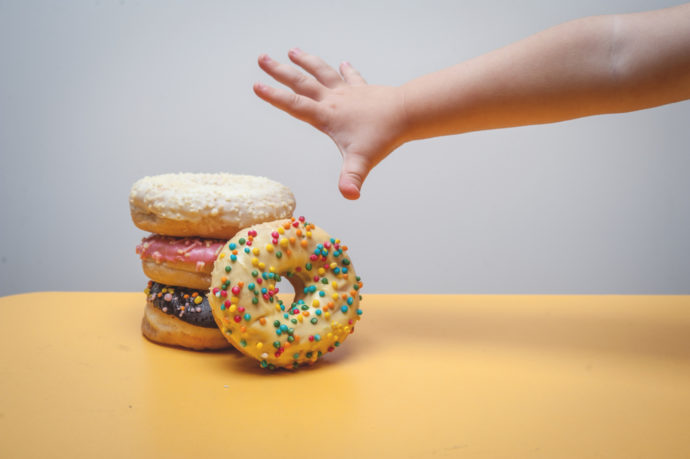Between Halloween and Thanksgiving, fall is the season of good eats, drinks, and lots of treats. According to a survey by Food Navigator USA, 42% of consumers plan to splurge on desserts this year.
But all those potlucks, school parties, and delicious deserts can lead to overindulgence – and tummy aches. The festivities of the season may also contribute the growing childhood obesity problem we have in the United States. According to the Centers for Disease Control and Prevention, 19.7% of children ages 2-19 in the U.S. are considered obese, which puts them at risk for long-term health problems.
To keep your family healthy this fall, here are a few tips to enjoy the great food of goblin and gobble season without any unwanted side effects.
1. Read the Label
Everyone loves those cookies and delectable treats that are in abundance this time of year. But too much of a good thing can lead to consuming too much sugar. Kids hopped up on sugar can experience tummy aches, mood swings, and the inevitable sugar crash.
Children should aim for eating less than 25 grams (six teaspoons) of sugar per day. Reading the label can help you decide how many treats your child can eat without negatively impacting their health.
Reading labels is extremely important if your child has food allergies or food sensitivities. Many kids have issues with certain food dyes and preservatives. Read the label and look for unwanted ingredients in your child’s favorite treats.
2. Brush, Brush and Don’t Rush
From gummy bears to hard candy, Halloween treats can do quite a number on young teeth. Emphasize the importance of brushing teeth thoroughly and flossing every day with your child. Kids should brush their teeth for a minimum of two minutes twice a day to prevent cavities. Setting a timer can help ensure they are brushing long enough. Find other tips to improve brushing from the American Dental Association.
3. Make Smart Choices at School Parties and Holiday Potlucks
When you are the cook, you know exactly what goes into what you are making. You and your child don’t have that same luxury at school parties and potlucks, where different families contribute all sorts of different foods. That chicken pot pie or decadent brownie may be full of calories, fat, food dyes, or other allergens.
While many schools only allow store bought items at parties, much of what is donated may be processed and contain too much sugar, food dyes, or preservatives that your child may be sensitive to.
Before any event that has a food spread where kids to take what they want, talk to your child about making healthy choices. Explain that it’s okay to have treats, but loading a plate full of cookies and skipping the carrot sticks may not be the best choice and could lead to a tummy ache.
Have them think about dividing their plate into sections, and adding something different for each section, such as cookies in one area, fruit in another, a cheese stick in another, and some popcorn in another. Adults attending work functions or other potlucks can use this tip as well to help with portion control.
Finally, while many parents will complain that there is no need to bring healthy food choices to school parties because they just go to waste, challenge that idea by making healthy food fun! At Halloween parties, fill food service gloves with popcorn and put a plastic spider ring on a finger. Do an apple or pretzel dipping bar where kids can dip these foods in melted chocolate or cheese. If you are donating items, consider donating cheese sticks instead of cookies. Kids will choose healthy options if they are interesting and available!
4. Empower Your Child to Ask Questions
If you have older children, you know that they will be hanging out with friends or going to sleepovers. Empower your kids to ask questions about what the food plan is. Will they order pizza or are their friend’s parents making dinner? If there is no plan, help them make one, such eating before they go or offering to take everyone out first. Have them pack healthy snacks to share.
5. Enjoy Treats in Moderation
With all the candy and treats–especially after a long night of trick-or-treating, kids can’t help but want to eat every piece of chocolate they can get their hands on. Eating treats is part of childhood but help them understand that it is better to eat treats in moderation. Instead of eating 10 pieces of candy, save some for the next day. You can even sort candy into baggies labeled for future days to see how far they can stretch their Halloween candy. Kids who choose to eat three pieces a day could make their Halloween candy last until Thanksgiving – and beyond!
6. Teach them to Wash Their Hands Before Eating
From school party tables to grabbing candy from bowls on Halloween, kids come in contact with a lot of germs. Teach them to wash their hands before they eat anything. Make it a routine at home to wash hands before each meal. Model good behavior by washing your hands before you prepare food.
7. Be Mindful of Food Safety
Everyone gathers in the kitchen to make–or eat–great food from the fall harvest. To avoid food-related illnesses, be mindful of food safety, including:
- Keeping meat in the refrigerator until it is ready to be cooked
- Thawing frozen meat in the refrigerator instead of on the counter
- Washing cutting boards between chopping meat and vegetables
- Cooking meat to correct temperature
If your child is a budding chef, teach them safe handling of food as well. The Centers for Disease Control and Prevention offers these food safety tips for the holidays.
Eat and Enjoy!
Sharing meals and treats goes beyond just nourishment. Food brings family and friends together. Enjoy this time of year with friends, family, and loved ones and enjoy the special treats that are served each fall. Eat and be merry–but mindful–to stay health all year long.
Niki Taylor is a communications consultant with Niki Taylor PR.





